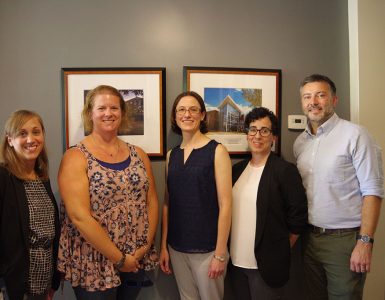Psychiatrist Studies Link of Nightmares to Suicide Risk
SHE LONGS for June*.
“I know I am in there,” says the pretty, articulate 35-year-old. But for now, she struggles with nightmares, with depression, with daily
thoughts that life without the true June isn’t worth living.
“I don’t want to keep living every day wanting to die and then going to sleep and dreaming about dying and then waking up and feeling like dying just over and over and over,” June says.
FACT: SUICIDE IS A LEADING CAUSE OF DEATH ACROSS ALL AGES AND THE THIRD LEADING CAUSE OF DEATH OF AMERICANS UNDER AGE 30.
A Vivid Imagination
NOT THAT many years ago, a vibrant, athletic, “Miss Everything” valedictorian of her high school could think only of life. For her early success in high school, her parents paid for June and her best friend to enjoy a holiday in Mexico before their daughter began studying architecture at Clemson University.
That’s when she was raped.
In retrospect, it was “just stupid,” she says. “Stupid girls think they are so old and know everything. We were in another country and didn’t.” June thought she could ignore what had happened. She went home, went to college. It gave her an odd sense of control to change her major to Spanish. But the sexual violence was always in her head, despite valiant efforts to keep it out.
She blames her earliest nightmares on her vivid imagination.
Long before Mexico, when she was still living a sort of dream, the dinosaurs she loved as a child would haunt her sleep. The huge reptiles would start out in a parade down her street, then go rogue, crashing into her house and destroying everything. “I had it [happen] all the time. Things that I loved to study, for whatever reason, my mind just . . .,” she trails off. Sometimes, she could wake herself up.
There were also wonderful things happening, even after Mexico. It turned out that the Spanish major was a great decision and she loved teaching it to children of almost any age, although the youngest pupils were her favorites. She relocated from her beloved seaside community to the Augusta area where she met and married a man with solid roots and broad shoulders. Two beautiful children followed, a boy and a girl, two years apart.
Out-of-Body Experience
BUT KEY pieces were crumbling. Her son, her oldest, was struggling. He still wasn’t walking at 18 months, so the family began an arduous journey of speech, feeding, and occupational therapy. June’s physical health was challenged as the lack of a daily saline rinse from the sea breeze coupled with exposure to Augusta’s abundant
inland allergens led to sinus problems, surgery, and an MRSA infection that required intravenous antibiotics for months. Depression, which had hovered for more than a decade, finally settled in. A nervous breakdown meant another hospitalization for June. She could feel herself having it. “It was almost like an out-of-body experience.” She had to leave the teaching job she loved and lost her identity outside her home.
Her nightmares became more intense. She dreamed of being in the thick of the real horrors of Hiroshima, the Dachau concentration camp, and the bombing of Dresden. And though trauma victims often relive what happened in their nightmares, her rape seems to manifest itself in “inappropriate dreams” that make her feel ashamed, she says, searching for the right words. “Like I am not normal.” The woman who hates needles started cutting herself and getting tattoos to fight a daily, strong impulse to do far worse.
The main reason she fights and seeks help is those two beautiful children. “The only way to keep going is to have faith that today is going to be better than yesterday and that tonight is going to be better than last night.”
Scanning the Scenes
THE CLASSIC nightmare is visual, narrative, and horrific, says Dr. Vaughn McCall. While the storyline may be tough to follow, there seems to be a sense of progression
and a fairly strong memory of the nightmare upon waking. Nightmares occur during rapid eye movement sleep. “Your eyes are actually moving almost as if they are scanning the scenes being created in your mind,” said McCall, Chairman of the MCG Department of Psychiatry and Health Behavior.
McCall is looking for a way to help treat nightmares tied to a daytime horror and ultimate thoughts of suicide.
“Most of us dream, most dreams don’t wake us up, and most of us don’t have nightmares,” says McCall, an expert in insomnia, depression, and suicide. While an occasional nightmare is likely of concern only in the moments that follow, those tied to a major traumatic experience can become part of the nightly routine.
Insomnia, depression, and suicide feed on each other, and as McCall has found, insomnia directly feeds suicide when patients lose hope they will ever get another good night’s sleep. McCall, who in a separate study is treating insomnia in addition to depression to target suicide risk, says nightmares are actually a slightly stronger suicide risk in patients with post-traumatic stress disorder.
Reliving Trauma
NIGHTMARES appear to make bad matters worse by compelling victims to relive their trauma even in their sleep. As with many things that go bad in the body, the intent seems good: the brain is trying to work through or resolve the traumatic event, McCall says.
But often, there is no resolution. A classic example is the war veteran who has seen combat buddies mutilated and killed. “When the soldiers return stateside, their daytime symptom of PTSD would be hypervigilance; they startle very easily. They tend to scan their environment, looking for threats like they were still in a war zone. At nighttime, their dreams become a reliving of the experience they had in the war zone,” McCall says.
While selective serotonin reuptake inhibitors, drugs such as Prozac and Zoloft, are approved for PTSD and can help with daytime problems such as irritability, they essentially do nothing for nightmares and other related sleep disturbances, McCall says.
Classic sleep medicines, such as those he is using to intervene between insomnia and suicide, likely won’t help either because they can actually make it easier for the brain to fantasize. Image rehearsal therapy, in which a patient and therapist rewrite the script of a nightmare so it ends well, appears to help some patients.
McCall is hoping that a seldomused blood pressure medicine, prazosin, may also help by blocking some of the adrenaline response in the brain. “We are looking for patients with PTSD who are getting treatment but still having nightmares and are no longer certain that life is worth living,” McCall says.
Adrenaline is a hormone and neurotransmitter that spikes temporarily in moments of anger or excitement, and more chronically in conditions such as PTSD where it contributes to hypervigilance.
Ramping it Down
“THE PREMISE is that individuals who have been through a trauma are on edge, and one of the chemical systems that keeps them on edge is their noradrenalin system, which is ramped up too high. This helps the whole system ramp down,” McCall says.
In fact, prazosin is already used for nightmares and recommended for such by the American Academy of Sleep Medicine. But McCall’s small pilot study, called Rest-On, appears the first to look at its impact on increased thoughts of suicidal thinking and suicide in PTSD patients with nightmares. He hopes the small study of 20 patients, funded by the American Foundation for Suicide Prevention, will lead to a larger one, such as his National Institutes of Health-funded study looking at the ability of sleeping pills to intervene in insomnia and those suicidal thoughts.
“The conceptualization is pretty similar,” he says. “It all goes back to what happens when you close your eyes.”
*Name changed










